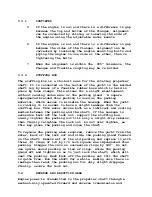
5.1.1
CONTINUED
An, electric fuel gauge registers the amount of fuel in the
tank. The fuel tank should never be allowed to run low, both for
safety reasons and to prevent water condensation, which is
enhanced in a partially filled tank.
5.1.2 FUEL FILTERS
One of
the major causes or engine failure is fuel contaminated
with sediment dirt or water. The use of
a good grade of clean
fuel purchased from a reliable source is mandatory.
In order to protect your engine a primary fuel-water separator
filter is placed in the suction fuel line of
each eng1ne ahead
of the filters supplied by the engine manufacturer. This filter
should be replaced every 100 hours or once a season, whichever
comes first. Presence or water should be checked on a daily
operating basis and draining should be done as required. Refer
to the engine instruction manual for maintenance of the engine
filters.
5.1.2
SAFE FUELING PRACTICES
The following fueling procedure is recommended:
1.
Avoid fueling a boat at night or in rough waters
except in an emergency.
2.
Before opening the fuel fill deck plate:
a. Extinguish all open flames aboard
including galley equipment.
b. Forbid all smoking on board or on the fuel
dock Drown all butts.
c. Stop the engine.
d. Turn the Battery Selection Switch to "OFF" to
be sure there is no live electrical circuit
on board during fueling. (Do not turn the
switch "OFF" until the engine is stopped to
avoid damage to the alternator.)
e. Tightly close all hatches.
Summary of Contents for 299
Page 1: ......
Page 2: ......
Page 53: ......
Page 54: ......
Page 55: ......
Page 56: ......
Page 57: ......
Page 58: ......
Page 59: ......
Page 60: ......
Page 61: ......
Page 62: ......
Page 63: ......
Page 64: ......
Page 65: ......
Page 66: ......
Page 67: ......
Page 68: ......
Page 69: ......
Page 70: ......
Page 71: ......
Page 72: ......
















































